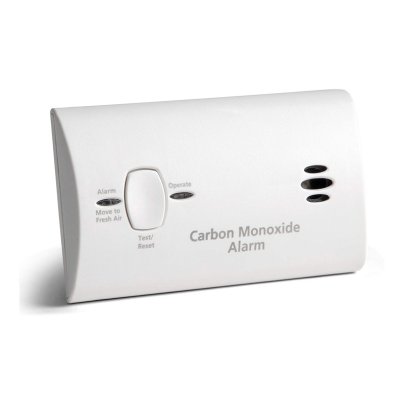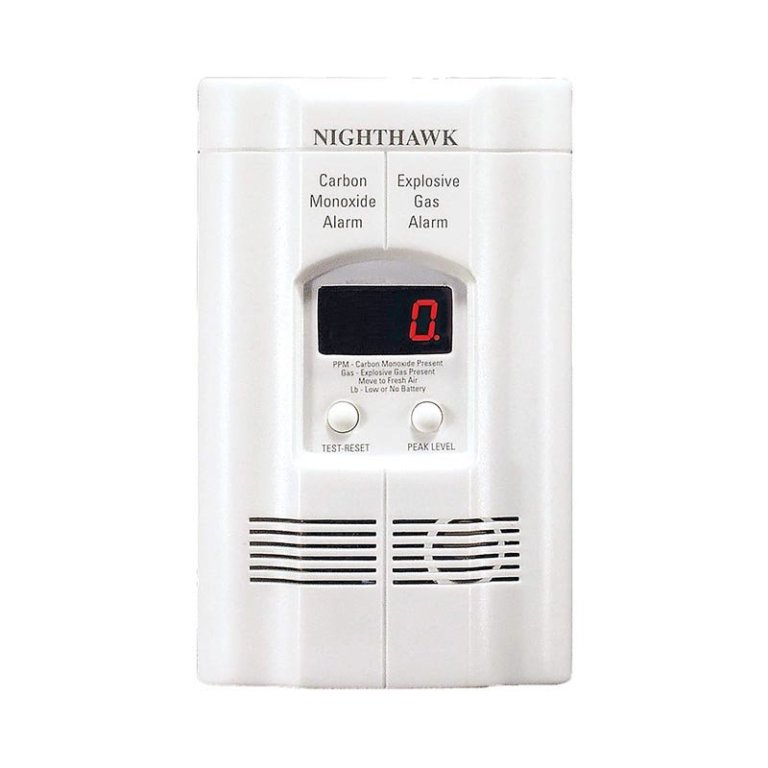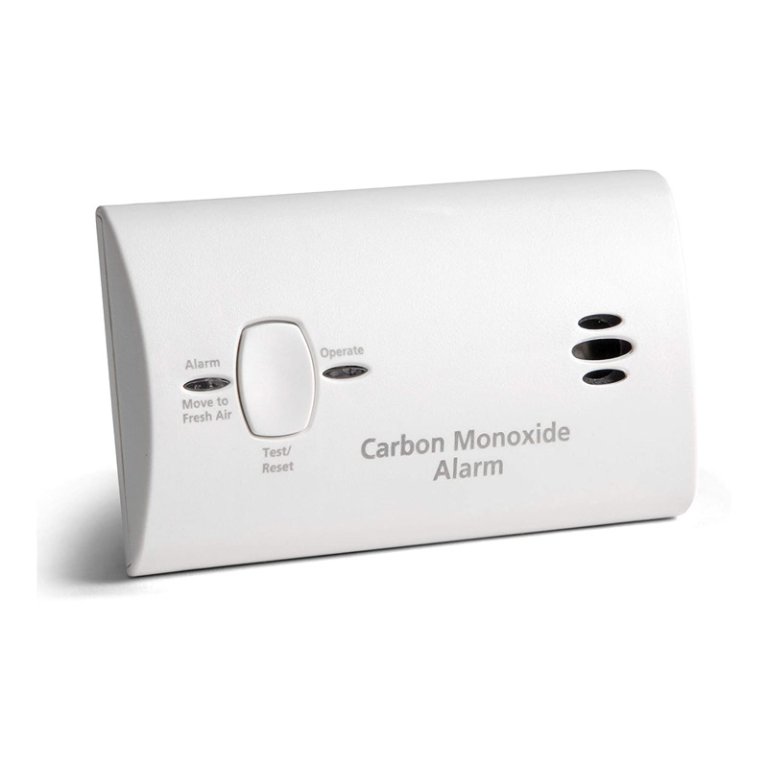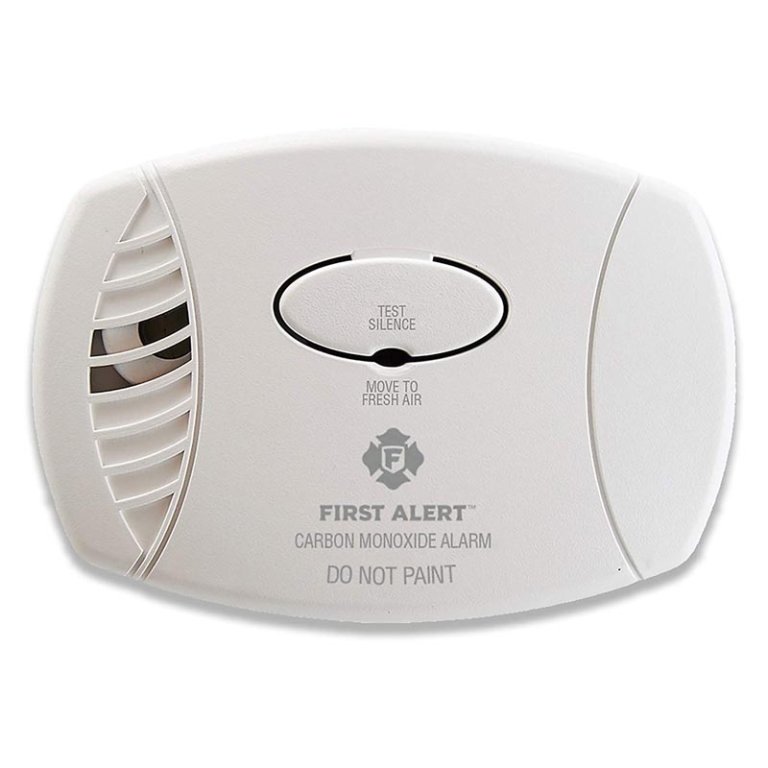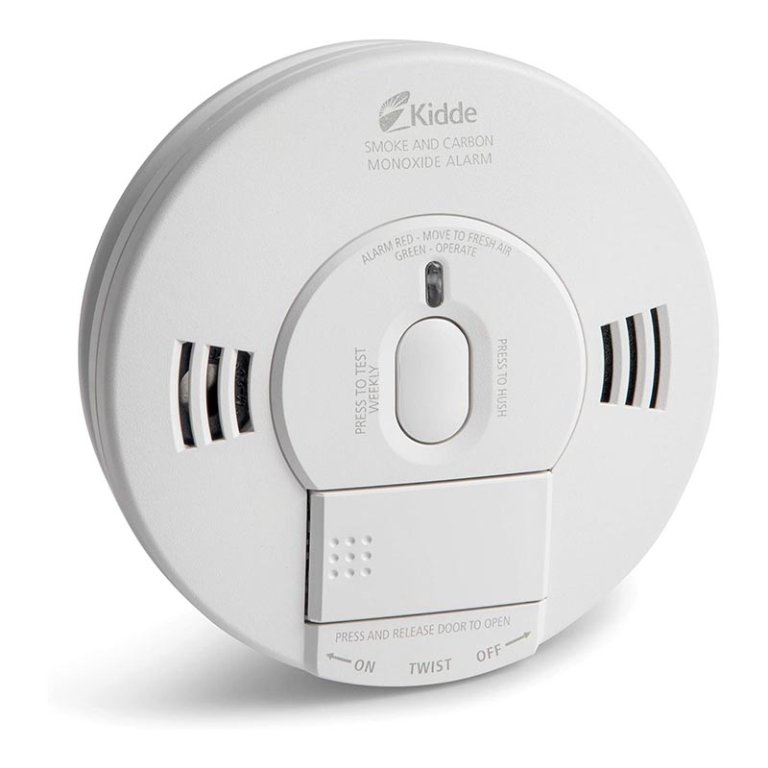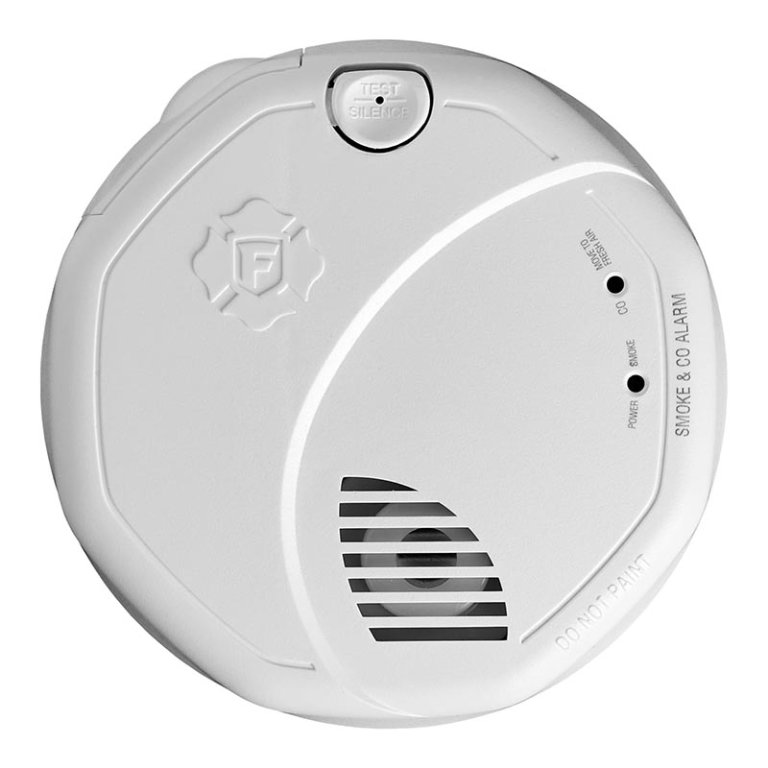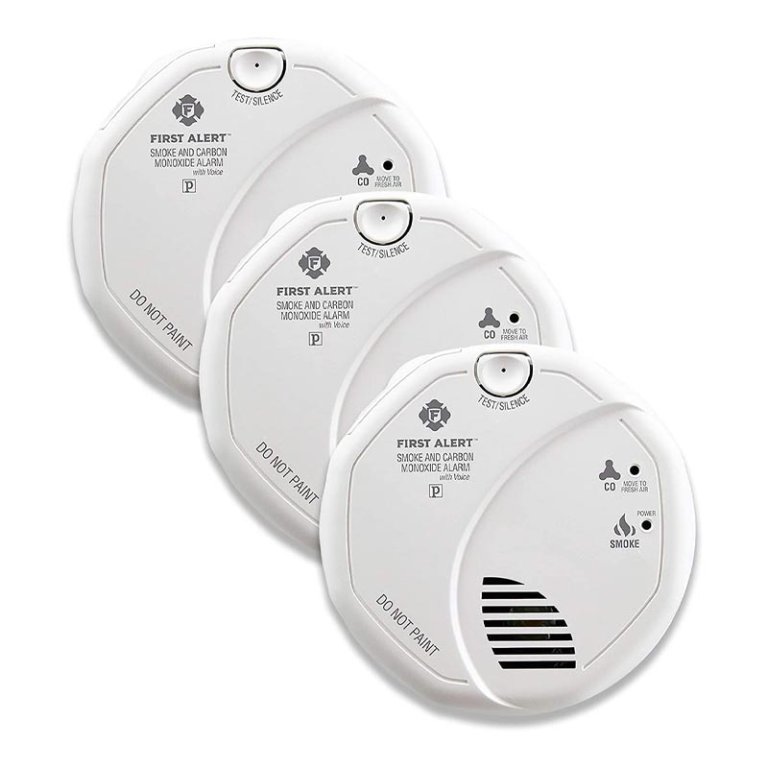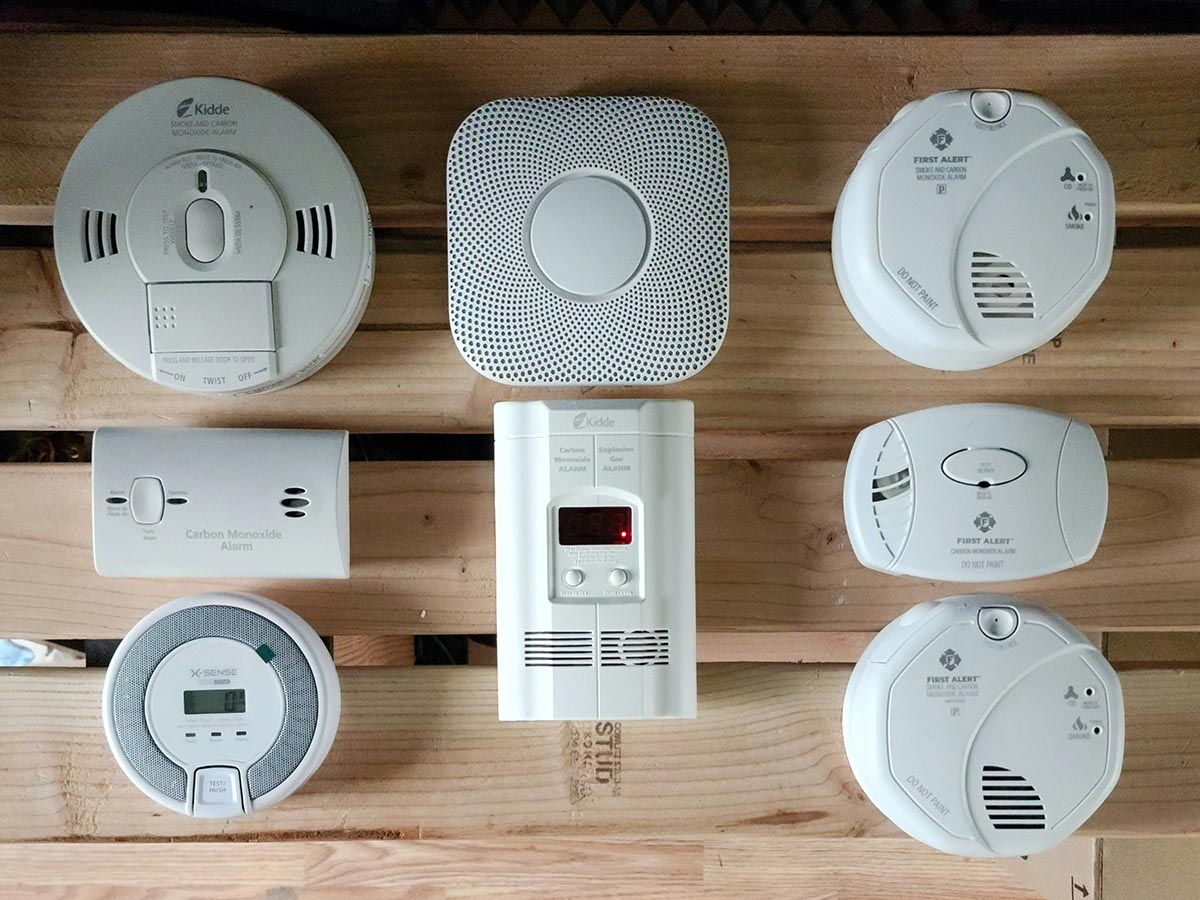
We may earn revenue from the products available on this page and participate in affiliate programs. Learn More ›
A home fire safety plan is incomplete without a carbon monoxide detector, which senses odorless, poisonous carbon monoxide (CO) gas and alerts residents to its presence. Without a comprehensive system of CO detectors, a family can be at serious risk. This gas can overwhelm occupants as they sleep, and typical symptoms—dull headache, dizziness, and confusion—may not be noticed.
There are a variety of different types of these crucial devices, so we tested eight of the most popular models to see how they’d fare in real-life situations. We also interviewed Steve Lockwood, owner of Mountain State Fire Protection LLC, to get his expert opinion. Based on our tests and Steve’s insights, we chose the Kidde Nighthawk carbon monoxide and explosive gas alarm as our top pick for its versatility, value, and digital display. Read on to learn how to choose a model for your own home, and see why the units we tested are considered among the best carbon monoxide detectors available for home safety.
- BEST OVERALL: Kidde Nighthawk Carbon Monoxide/Explosive Gas Alarm
↓ Jump to Review - BEST BANG FOR THE BUCK: Kidde Battery-Operated Carbon Monoxide Detector
↓ Jump to Review - BEST PLUG-IN: First Alert CO600 Plug-In Carbon Monoxide Detector
↓ Jump to Review - BEST HARDWIRED: Kidde Firex AC Hardwired Carbon Monoxide/Smoke Alarm
↓ Jump to Review - BEST COMBINATION: First Alert SCO5CN Smoke/Carbon Monoxide Detector
↓ Jump to Review - BEST SMART UNIT: Google Nest Protect Smoke and Carbon Monoxide Alarm
↓ Jump to Review - BEST DIGITAL DISPLAY: X-Sense Carbon Monoxide Detector
↓ Jump to Review - BEST MULTIPACK: First Alert SC7010BV Smoke/CO Alarm w/Voice & Location
↓ Jump to Review
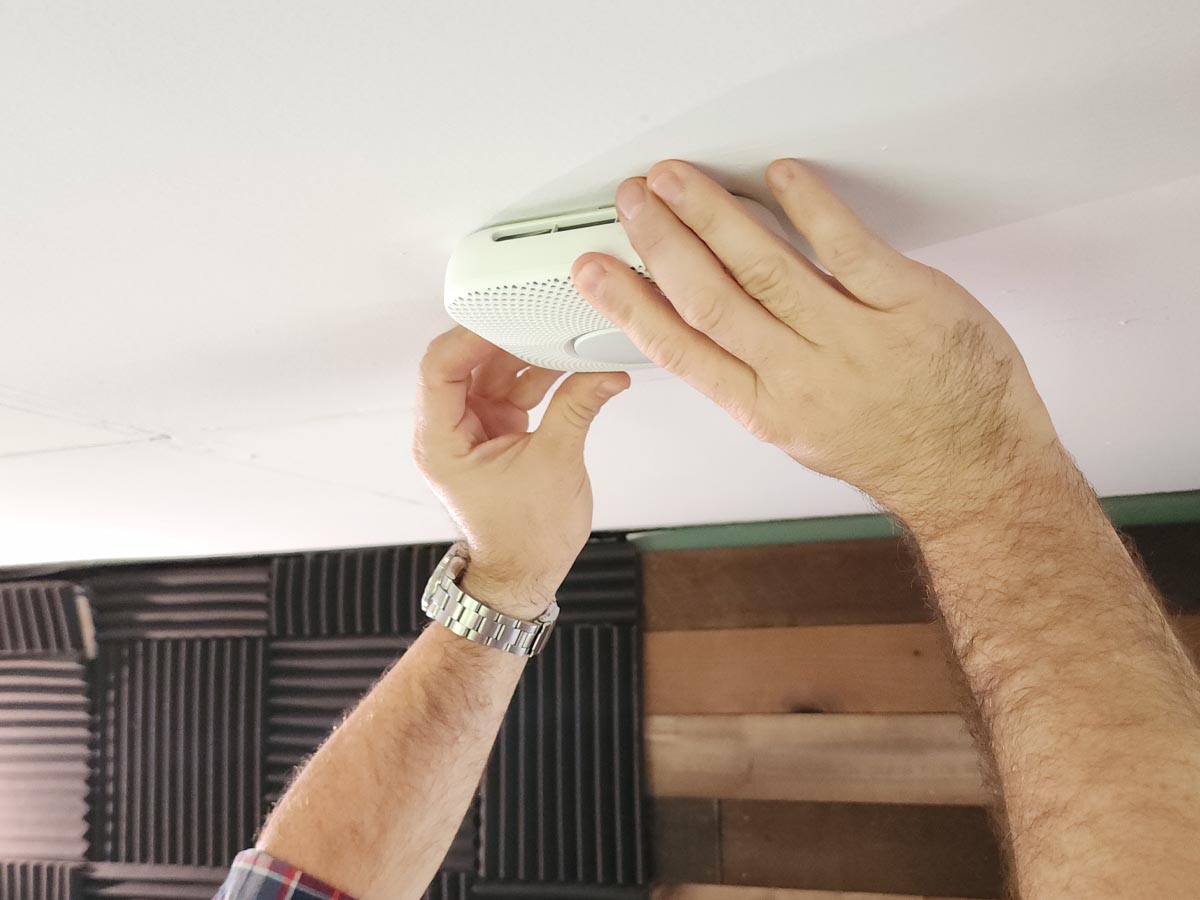
| Testing Stats | |
| Products tested | 8 |
| Hours/Weeks/Time spent testing | 8 hours |
| Tests performed | 4 |
| Price range | $20 to $200 |

Carbon Monoxide and How It’s Detected
Carbon monoxide is generally a byproduct of combustion, meaning any appliance that uses a fuel source (such as a water heater, furnace, or boiler) produces carbon monoxide when running. These appliances are extremely safe when working properly, but carbon monoxide can build up to dangerous levels if something goes wrong.
According to Steve Lockwood, owner of an Arizona-based company offering fire equipment installation and comprehensive fire protection services, “CO detectors are important because carbon monoxide is a tasteless and odorless gas that can only really be detected by a properly rated detector.” Steve goes on to say that leaks that occur while you’re asleep are especially dangerous, as high levels of carbon monoxide will keep you asleep and cause eventual poisoning.
Carbon monoxide is measured in parts per million (PPM). Exposure to 50 PPM is safe for up to 8 hours, while 150 PPM is dangerous after 50 minutes, and 1,600 PPM can kill a healthy adult in under an hour. Carbon monoxide detectors are important because the gas is colorless and odorless, so it’s impossible to sense its presence until it’s too late.
Low-level carbon monoxide alarms track levels of CO gas over time and sound a loud alarm when those levels exceed certain parameters. For instance, a 50 PPM measurement will activate most alarms within 8 hours, 150 PPM within 50 minutes, and 400 PPM within 15 minutes.
Our Top Picks
Carbon monoxide detectors are crucial to home safety. Consider the following models for various situations, and read on to learn which features to look for and how to choose the best model for a particular set of needs.
Best Overall
Kidde Nighthawk Carbon Monoxide/Explosive Gas Alarm
What We Like
- Flexible plug-in allows use within 6 feet of an outlet
- Battery backup ensures continued function, even in power outages
- Digital reading displays the amount of gas in the air
What We Don’t Like
- Large, bulky design
Product Specs
- Type: Carbon monoxide and explosive gas
- Power source: Plug-in or battery
- Interconnectivity: None
This Kidde carbon monoxide detector does more than simply sense dangerous levels of carbon monoxide; it can also detect the presence of explosive gases like propane and methane. Its digital display alerts you to real-time carbon monoxide levels in the home, while the peak-level function shows the highest point reached since it was last reset. Since explosive gas detection is not immediate, occupants may smell gas before the detector goes off if they’re awake. Still, it’s a great safety feature for peace of mind when the household is asleep.
This model plugs directly into an outlet or can be installed up to 6 feet away with the included cord adapter. It also has battery backup to ensure it’s functional even if the power goes out. In our tests, installation couldn’t have been easier, as all we had to do was insert batteries and plug it in. Once installed, however, we realized we weren’t big fans of the size (it’s much bigger than the other plug-in models). Since the digital display requires some extra space, we think the extra inches are worth it.
What our tester says: “I liked quite a few things about the Kidde Nighthawk. It was one of the only detectors responsive to our carbon monoxide test, alerting us that there were 157 PPM in the air at the peak. Also, I liked the flexible mounting options, as it can be installed anywhere within 6 feet of an outlet thanks to the included cord.”—Tom Scalisi, Product Reviews tester & writer
Get the Kidde Nighthawk carbon monoxide detector at Amazon, Walmart, or Kidde.
Best Bang for the Buck
Kidde Battery-Operated Carbon Monoxide Detector
What We Like
- Compact size
- Low price makes having multiple units affordable
- Very simple to set up and install
What We Don’t Like
- No additional features
Product Specs
- Type: Carbon monoxide
- Power source: Battery
- Interconnectivity: None
Reliable protection against poisonous levels of carbon monoxide needn’t be expensive, and the affordable price of Kidde’s battery-operated carbon monoxide detector makes it economical to install multiple units throughout the home. In testing, we found the beauty of the Kidde battery-operated carbon monoxide detector to be its simplicity. After inserting batteries and mounting the unit to the wall with two anchors and screws, this model was ready to go.
This detector uses 2 AA batteries and has a handy lockout feature on the battery door to prevent it from shutting without batteries in place. Its 85-decibel alarm is loud enough to alert residents if it detects carbon monoxide, and it also has an audible low-battery signal. This alarm from Kidde also has a built-in test button and two LEDs—green to indicate proper operation and red for dangerous levels of carbon monoxide.
In addition to this unit’s budget-friendly price tag, we also really like its compact size. It is a fairly basic model, so shoppers looking for interconnectivity or smart features will want to keep shopping.
Get the Kidde battery-operated carbon monoxide detector at Amazon, Walmart (with an additional smoke detector), or Blain’s Farm & Fleet.
Best Plug-In
First Alert CO600 Plug-In Carbon Monoxide Detector
What We Like
- Very simple design—just plug and play
- Loud siren
- Responded to CO test, thanks to test port
What We Don’t Like
- Shuts off when power goes out
Product Specs
- Type: Carbon monoxide
- Power source: Plug-in
- Interconnectivity: None
Folks who’d prefer the simplest form of carbon monoxide detection should consider the First Alert CO600. This device plugs into a standard wall outlet—there is no need for batteries or hardwired connections—and its compact design and prong placement won’t block both outlets in a double outlet.
This model features a loud 85-decibel alarm to alert residents to the presence of dangerous levels of carbon monoxide. It has one button for testing and resetting and no digital display or extra settings, making it as straightforward as these detectors get. The C0600 offers bare-bones but affordable carbon monoxide detection, and the unit installs quickly and does its job reliably.
Since this First Alert alarm has a test port in front of the sensor, we were able to use our can of faux CO to trigger it. The resulting beeps were loud enough to alert folks in any part of the house. Just be aware that this model will shut off if the power goes out, as there’s no backup battery.
Get the First Alert CO600 carbon monoxide detector at Amazon, Lowe’s, Walmart, or First Alert.
Best Hardwired
Kidde Firex AC Hardwired Carbon Monoxide/Smoke Alarm
What We Like
- Hardwired plug makes installing it into an existing system easy
- Battery backup ensures it can operate even if the power is out
- Very loud, clear, and intense voice alerts
What We Don’t Like
- The base was slightly finicky to operate
Product Specs
- Type: Carbon monoxide and smoke
- Power source: Hardwired or battery
- Interconnectivity: Yes, with up to 24 other devices when hardwired
Wired smoke detectors are typically basic, but this combination smoke and carbon monoxide model from Kidde has some great features. For one thing, the hardwired smoke and carbon monoxide detector shouts voice alerts, warning users of smoke or carbon monoxide to ensure they understand the hazard involved.
This model from Kidde is also flexible. You can link it to an existing fire alarm system with the included wiring plug or operate it by installing a 9-volt battery in the front of the unit. Since it is hardwired, it can interconnect with up to 24 other devices, including other smoke, carbon monoxide, or heat detectors.
While the Kidde Firex combination smoke detector is a hardwired model, we appreciated the flexibility of power sources between wired power or batteries. The voice alerts proved to be very loud, intense, and clear. We did find the base slightly finicky to deal with, as there’s a small release mechanism that we needed to locate, but beyond that, using this smoke detector was extremely simple, down to the front-mounted battery.
Get the Kidde Firex carbon monoxide detector at Amazon.
Best Combination
First Alert SCO5CN Smoke/Carbon Monoxide Detector
What We Like
- Features 2 reliable detection sensors
- Base has locking pin to prevent battery disconnection
- Easy to install; requires no wiring
What We Don’t Like
- Confusing battery drawer
Product Specs
- Type: Carbon monoxide and smoke
- Power source: Battery
- Interconnectivity: None
This unit is for you if you want a dependable, battery-powered combination smoke and CO detector. Since it’s battery-only, the First Alert SCO5CN can be installed anywhere. Its base features locking pins to ensure the battery drawer stays shut and the batteries stay in place.
This combo unit has a photoelectric sensor for smoke detection and an electrochemical sensor for carbon monoxide detection—both tried-and-true, reliable sensors. It has a test port, and our can of imitation CO gas triggered its alarm during tests. Its loud 85-decibel beeping is sufficient to wake dozing residents.
After testing multiple battery-operated units, however, this one initially threw us for a loop. Installing the batteries took a little trial and error, but we really liked this model once we figured that out.
What our tester says: “The First Alert battery drawer confused and frustrated us. Rather than swinging outward from the unit, it pulls straight out like a dresser drawer. Once we got used to that, we found the First Alert to be very effective and easy to install.”
Get the First Alert SCO5CN carbon monoxide detector at Amazon or Walmart.
Best Smart Unit
Google Nest Protect Smoke and Carbon Monoxide Alarm
What We Like
- Clear, specific alerts regarding hazard and location
- Physical installation and setup with the app are both very simple
- Wi-Fi smoke detector and CO alarm combo is convenient
What We Don’t Like
- Wouldn’t link with our Google Home app
Product Specs
- Type: Carbon monoxide and smoke
- Power source: Battery
- Interconnectivity: Yes, with other Nest devices
The Nest Protect smoke and CO alarm from Google is a great option for smart homes. It detects both smoke and carbon monoxide and can alert you to a problem even if you aren’t home.
When the Nest activates, it alerts the app, the smart home system, and a central monitoring company. Being interconnect capable, it will also activate other smart-alarm devices. The unit also provides voice alerts about the hazard and the room where it’s detected.
The Google Nest Protect was one of our favorite models to test. Its voice alerts are clear and easy to understand, and we even liked its cool yet unobtrusive appearance (it looks like a speaker). The base allows plenty of swivel, meaning users can easily align their Nest Protect with their home’s walls for a clean, square installation. Our one complaint is that, despite easily adding this model to the Nest app, we haven’t been able to add it to our Google Home app.
Get the Google Nest carbon monoxide detector at Amazon, Lowe’s, The Home Depot, Walmart, Best Buy, Costco (2-pack), or Google.
Best Digital Display
X-Sense Carbon Monoxide Detector
What We Like
- Slim, compact design
- Real-time CO readings
- Users needn’t check digital display to know overall condition
What We Don’t Like
- No recall button
Product Specs
- Type: Carbon monoxide
- Power source: Battery
- Interconnectivity: None
When it comes to having enough coverage for an entire home, purchasing a set of detectors may make the most sense. With this three-pack of carbon monoxide detectors, users can cover most of their fire and CO safety needs. Each unit has a built-in battery with an up to 10-year lifespan.
This model’s carbon monoxide sensor takes readings and shows PPM on its easy-to-read LCD display. Each unit has an LED light that indicates green for proper function, yellow for a fault, and red for an alarm. Though these seemed like great features before testing, we have some experience with X-Sense products, and what has seemed good in theory hasn’t always been great in practice.
This time, however, X-Sense has addressed some of the issues that bothered us previously by creating a high-quality, streamlined carbon monoxide detector. Its digital display is very easy to understand, yet the detector is still low-profile and compact. It provides real-time readings, even if there’s no need for the detector to sound an alarm. We would prefer it had a recall button that displayed the highest detected levels since the last reset, but overall, it worked well and changed our perception of X-Sense.
Get the X-Sense carbon monoxide detector at Amazon.
Best Multipack
First Alert SC7010BV Smoke/CO Alarm w/Voice & Location
What We Like
- Voice alerts to state precise hazard and location
- Choice of 11 pre-programmed locations
- Programming devices to the location is very easy
What We Don’t Like
- Speaker sounded slightly muffled
Product Specs
- Type: Carbon monoxide and smoke
- Power source: Hardwired or battery
- Interconnectivity: Yes, with up to 18 other devices when hardwired
If your old smoke detectors are nearing the end of their life, it may be time to look into a multipack like First Alert’s combination smoke and CO alarm. The SC7010 models feature voice alerts that state the hazard to help disoriented residents better understand what’s happening. When hardwired, these units can interconnect with other alarms throughout the home. They also let you choose from 11 preprogrammed locations during installation, so users know exactly where the issue is.
In testing, we found programming the location for these units to be very simple—surprising, considering there is only one button. However, the speaker did sound a bit muffled, so announcing voice locations might not be as clear as some folks would prefer. The units do have an accompanying alarm, though. We also liked that these models come with easy-to-wire plugs and bases that proved simple to install.
Get the First Alert SC7010BV-3 carbon monoxide detector at Amazon, Lowe’s, (single unit), Walmart (single unit), or First Alert (single unit).
Jump to Our Top Picks
How We Tested the Best Carbon Monoxide Detectors
We wanted to recommend only the best carbon monoxide detectors, so we did our homework. We performed extensive product research to choose top-rated models, then performed hands-on testing to ensure they had the goods.
First, we installed each model according to the manufacturer’s instructions. Then, we attempted to test them with a can of faux carbon monoxide. We quickly realized that this part of the test was flawed, as most models require prolonged presence of carbon monoxide to alert. However, some models had test ports and were compatible with the test.
Next, we activated each carbon monoxide detector and traveled to the far side of the house to ensure we could hear them. We learned that the sirens are always effective but that sometimes voice alerts can be too hard to hear (thankfully, they all have sirens as well). The final step was to test additional features, such as recall buttons and apps, to get to know what each model could do.
What to Consider When Choosing a Carbon Monoxide Detector
Carbon monoxide alarms are important tools to test air quality in your home. But before you buy one, it’s worth taking time to ensure you choose the right type, power supply, and set of additional features.
Types of Carbon Monoxide Detectors
There are two types of carbon monoxide detectors on the market: stand-alone and combination models. Choosing the correct type for a home depends on several factors.
Stand-alone
A stand-alone carbon monoxide detector’s only job is to detect and measure the levels of CO gas in the home. Battery-operated models can be placed nearly anywhere and are the more popular choice. For a more stationary carbon monoxide detector placement, choose a plug-in detector. These models often have digital readouts that display the current level of carbon monoxide.
Combination
Combination units are multipurpose, monitoring carbon monoxide levels while also detecting smoke or explosive gases. The benefit of combination units is that they take much of the planning and guesswork out of building a fire safety system. The downfall is that combination carbon monoxide detectors shouldn’t be near gas or oil-fired appliances. In these areas, a stand-alone battery or plug-in smoke detector is best used with a separate stand-alone carbon monoxide detector installed farther away.
Contrary to popular belief, standard carbon monoxide detectors do not detect the presence of explosive gases like methane, propane, or sewer gas. This is because explosive gases don’t contain carbon monoxide unless accompanied by burnt fuel. However, carbon monoxide detectors equipped with explosive gas detection capabilities will pick up on other dangerous gases and alert residents to their presence.
Power Supply
You can purchase carbon monoxide detectors that have different power supply options. Depending on your home and needs, a comprehensive system could include units from all three categories.
- Battery-powered CO detectors: These don’t require outlets or preexisting wiring and can be placed virtually anywhere in the home. Their convenience makes them great additions to garage workshops that use propane heat. It’s also smart to pack one in your suitcase as a portable carbon monoxide detector when traveling.
- Plug-in models: Since these detectors require an outlet, planning their installation location before purchase is important. Luckily, most of these units have battery backups for more flexible installation and as a safety feature should the power go out.
- Hardwired models: These units use preexisting fire alarm wiring and battery backups for their power source. While hardwired units are reliable, not every home has the wiring necessary to install these in every room.
UL Listing
Just like the best smoke detectors, carbon monoxide detectors must be listed by Underwriters Laboratories (UL). The UL listing on the back of the unit indicates that the design was tested and passed UL’s stringent requirements.
Digital Displays
Digital displays may seem unnecessary, but they actually serve a fairly important purpose. These units display the PPM of any amount of carbon monoxide they detect, even if the alarm mode doesn’t need to be activated. This can help residents determine if there is more baseline carbon monoxide in the home than they thought.
Interconnectivity
Interconnect-capable units are carbon monoxide detectors that can be programmed or wired with other alarm devices in the home through radio-frequency, Wi-Fi, or direct wiring. This means that an alarm triggered in one area will trigger connected alarms to ensure occupants are aware of an issue regardless of their location in the home. If the devices report to a central monitoring station, the alarm company will notify first responders and send help without the resident even picking up the phone.
Smart Features
Detection devices have joined the ranks of smart appliances and fixtures, like refrigerators, faucets, and air quality monitors. Steve Lockwood, owner and operator of Mountain State Fire Protection LLC, appreciates the advancements of smart technology in CO alarms, noting “They even have Bluetooth models, which I like because they can notify you of potential hazards while you are away.” These models are often combination smart smoke detectors and carbon monoxide alarms.
Smart CO detectors can communicate with a mobile, base station, or smart-home system. They can also be programmed to describe the area and type of device that’s been activated as well as provide real-time condition updates, such as room temperature, to an app.
Tips for Using Carbon Monoxide Detectors
The general consensus is that a carbon monoxide detector should be installed on every floor of a house, inside (or just outside) of every bedroom, and in your basement and garage.
To ensure proper operation of CO alarms, follow the same guidelines used for smoke detectors. Test each carbon monoxide detector monthly and replace batteries yearly, regardless of whether the low-battery alarm sounds.
Even if the batteries in a carbon monoxide detector are changed regularly, the detectors don’t last forever. The lifespan of a carbon monoxide detector—usually between 5 and 7 years—is typically printed on the back of the alarm. If you can’t find this information and don’t remember when you purchased the device, consider replacing it now.
- Install CO detectors on every floor of your house and in every bedroom
- Put additional alarms in the basement and garage
- Test all detectors monthly and replace batteries every year
- Replace CO detectors every 5 to 7 years, according to manufacturer recommendations
FAQs
Although you’ve read up on carbon monoxide detectors and how to choose one, you may still want more information on purchasing and using these essential devices. To be more fully informed, check out the answers to the most frequently asked questions about the best carbon monoxide detectors.
Install detectors in bedrooms or hallways outside sleeping areas. Make sure there is at least one carbon monoxide detector per floor and inside the garage. Since carbon monoxide is slightly lighter than air and travels up with warm, rising air, the best installation height is about 5 feet above the floor.
The Centers for Disease Control and Prevention recommend installing at least one carbon monoxide detector per floor, but the more, the better. If you need an RV carbon monoxide detector, a single unit will likely be sufficient.
They each have benefits, and one is not more effective than the other (unless the power goes out and the plug-in unit doesn’t have a battery backup). A combination of battery, plug-in, and hardwired detectors might provide the best coverage.
If your carbon monoxide detector is beeping, leave your house immediately. Once you’re safely outside, call 911 to report the issue and seek medical attention if you or anyone else is experiencing symptoms of carbon monoxide poisoning, such as headache, dizziness, or vomiting. Do not go back inside until first responders have cleared your home. (Note that a smoke detector beeping will produce three extended beeps, whereas most standalone CO detectors produce four short beeps.)
Meet the Tester
Tom Scalisi is a freelance writer specializing in the home design, construction, tools, and automotive industries. He has been involved in the trades for over 15 years as both a contractor and a commercial building mechanic. His work has been featured on This Old House, Family Handyman, and Forbes. He also owns and operates a pest control blog RiddaBugs.com. As a lover of all things tools, construction, and DIY, he’s always looking for new tools and techniques while also sharing his knowledge with the DIY world.

